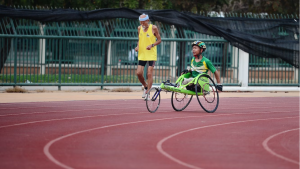Oscar Pistorius, a South African sprinter, had both of his legs amputated below the knee when he was just 11 months old. The cause of this amputation was a congenital condition known as fibular hemimelia, which means he was born without fibulas—the long, slender bones on the outer sides of the lower legs. This condition also affected the development of his feet.
Oscar’s parents, Henke and Sheila Pistorius, made the difficult decision to amputate his legs to give him the best chance at mobility and a more functional life. This choice allowed for the fitting of prosthetic limbs, enabling Pistorius to walk and eventually participate in various sports.
Also Read: Percy Jackson and the Olympians: Release date, trailer, cast, plot, director and more
Despite his physical challenges, Pistorius demonstrated remarkable athleticism from a young age. He initially engaged in rugby and water polo before discovering his passion for running. Pistorius excelled in sprinting, competing against able-bodied athletes and achieving considerable success.
Pistorius’s journey as a Paralympic athlete gained significant attention, and he became known as the “Blade Runner” due to his use of carbon-fiber prosthetic blades during competitions. His prosthetic limbs were designed to replicate the function of natural legs, providing spring-like support and propulsion.
Also Read: Who was Oscar Pistorius’ girlfriend, Reeva Steenkamp?
While Pistorius’s rise to fame was initially celebrated for breaking barriers between able-bodied and disabled athletes, his life took a tragic turn in 2013 when he was charged with the murder of his girlfriend, Reeva Steenkamp. The subsequent legal proceedings, trial, and conviction shifted the focus from his sporting achievements to a high-profile criminal case that captured global attention.







